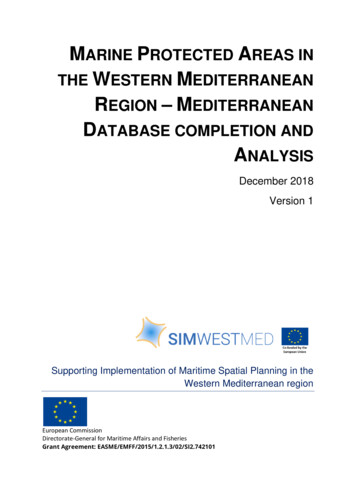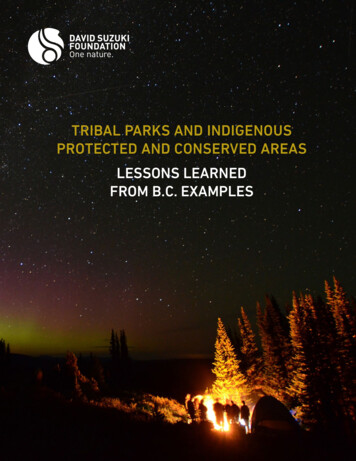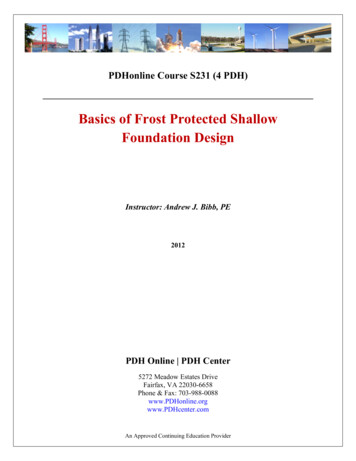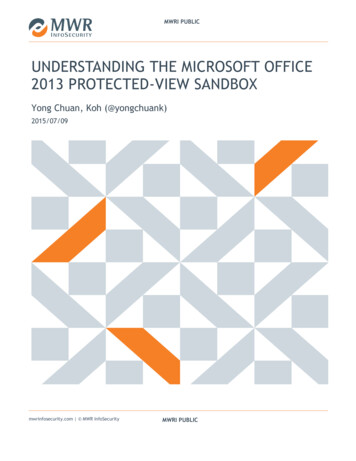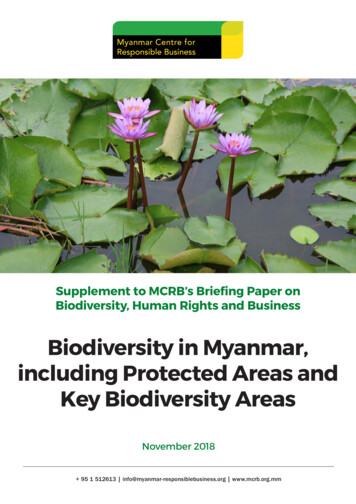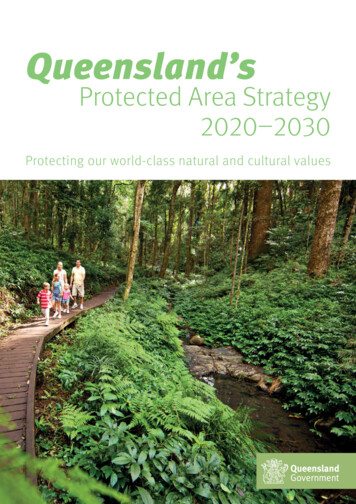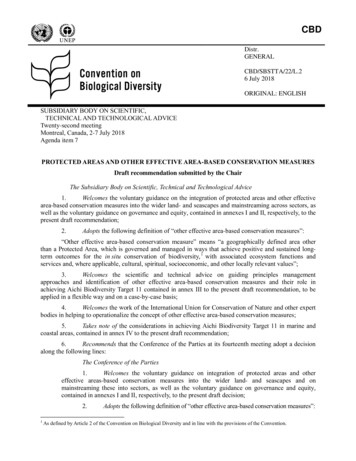
Transcription
CBDDistr.GENERALCBD/SBSTTA/22/L.26 July 2018ORIGINAL: ENGLISHSUBSIDIARY BODY ON SCIENTIFIC,TECHNICAL AND TECHNOLOGICAL ADVICETwenty-second meetingMontreal, Canada, 2-7 July 2018Agenda item 7PROTECTED AREAS AND OTHER EFFECTIVE AREA-BASED CONSERVATION MEASURESDraft recommendation submitted by the ChairThe Subsidiary Body on Scientific, Technical and Technological Advice1.Welcomes the voluntary guidance on the integration of protected areas and other effectivearea-based conservation measures into the wider land- and seascapes and mainstreaming across sectors, aswell as the voluntary guidance on governance and equity, contained in annexes I and II, respectively, to thepresent draft recommendation;2.Adopts the following definition of “other effective area-based conservation measures”:“Other effective area-based conservation measure” means “a geographically defined area otherthan a Protected Area, which is governed and managed in ways that achieve positive and sustained longterm outcomes for the in situ conservation of biodiversity, 1 with associated ecosystem functions andservices and, where applicable, cultural, spiritual, socioeconomic, and other locally relevant values”;3.Welcomes the scientific and technical advice on guiding principles managementapproaches and identification of other effective area-based conservation measures and their role inachieving Aichi Biodiversity Target 11 contained in annex III to the present draft recommendation, to beapplied in a flexible way and on a case-by-case basis;4.Welcomes the work of the International Union for Conservation of Nature and other expertbodies in helping to operationalize the concept of other effective area-based conservation measures;5.Takes note of the considerations in achieving Aichi Biodiversity Target 11 in marine andcoastal areas, contained in annex IV to the present draft recommendation;6.Recommends that the Conference of the Parties at its fourteenth meeting adopt a decisionalong the following lines:The Conference of the Parties1.Welcomes the voluntary guidance on integration of protected areas and othereffective areas-based conservation measures into the wider land- and seascapes and onmainstreaming these into sectors, as well as the voluntary guidance on governance and equity,contained in annexes I and II, respectively, to the present draft decision;2.1Adopts the following definition of “other effective area-based conservation measures”:As defined by Article 2 of the Convention on Biological Diversity and in line with the provisions of the Convention.
CBD/SBSTTA/22/L.2Page 2“Other effective area-based conservation measure” means “a geographically defined areaother than a Protected Area, which is governed and managed in ways that achieve positive andsustained long-term outcomes for the in situ conservation of biodiversity, 2 with associatedecosystem functions and services and where applicable, cultural, spiritual, socio–economic, andother locally relevant values”;3.Welcomes the scientific and technical advice on guiding principles managementapproaches and identification of other effective area-based conservation measures and their role inachieving Aichi Biodiversity Target 11, contained in annex III to the present draft decision, to beapplied in a flexible way and on a case-by-case basis;4.Encourages Parties and invites other Governments, relevant organizations, incollaboration with indigenous peoples and local communities, to apply the voluntary guidancecontained in annexes I and II, on integration and mainstreaming, and governance and equity ofprotected areas and other effective area-based conservation measures, as appropriate, inaccordance with national circumstances and legislation, and consistent and in harmony with theConvention and other international obligations;5.Encourages Parties and invites other Governments, relevant organizations, incollaboration with indigenous peoples and local communities, to apply the scientific and technicaladvice on guiding principles and common characteristics, management approaches andidentification of other effective area-based conservation measures contained in annex III, alsotaking into account, where appropriate, the 2016 report of the United Nations Special Rapporteuron the rights of indigenous peoples on the theme “indigenous peoples and conservation”3 and the2017 report of the United Nations Special Rapporteur on human rights and the environment,4including by:(a)Identifying other effective area-based conservation measures and their diverseoptions within their jurisdiction;(b)Submitting data on other effective area-based conservation measures to the UnitedNations Environment Programme’s World Conservation Monitoring Centre for inclusion in theWorld Database on Protected Areas;6.Encourages Parties, and invites other Governments, relevant organizations andindigenous peoples and local communities to take into account the considerations in achieving AichiBiodiversity Target 11 in marine and coastal areas, as contained in annex IV to the present draftdecision, in their efforts to achieve all elements of Aichi Biodiversity Target 11 in marine and coastalareas;7.Encourages Parties and invites other Governments, relevant organizations,indigenous peoples and local communities, to share case studies/best practices and examples ofmanagement approaches, governance types and effectiveness related to other effective area-basedconservation measures, including experiences with the application of the guidance, through theclearing-house mechanism of the Convention and other means;8.Invites the International Union for Conservation of Nature and the WorldConservation Monitoring Centre to expand the World Database on Protected Areas by providing asection on other effective area-based conservation measures;9.Further invites the International Union for Conservation of Nature, the Food andAgriculture Organization of the United Nations, and other expert bodies to continue to assistParties to identify other effective area-based conservation measures and to apply the guidance;2As defined by Article 2 of the Convention on Biological Diversity and in line with the provisions of the Convention.Report of the Special Rapporteur of the Human Rights Council on the rights of indigenous peoples, Victoria Tauli-Corpuz (A/71/229).4Report of the Special Rapporteur of the Human Rights Council on the issues of human rights obligations relating to theenjoyment of a safe, clean, healthy and sustainable environment, John Knox (A/HRC/34/49).3
CBD/SBSTTA/22/L.2Page 310.Requests the Executive Secretary, subject to available resources, and incollaboration with partners, Parties, other Governments, relevant organizations and indigenous andlocal communities, to provide capacity-building including training workshops to enable theapplication of the guidance contained in the annexes to the present draft decision;11.Urges Parties, and invites other Governments, relevant organizations and donorsin a position to do so, to provide resources for capacity-building, and to support Parties andindigenous peoples and local communities to identify other effective area-based conservationmeasures and to apply the guidance;12.Urges Parties to facilitate mainstreaming of protected areas and other effectivearea-based conservation measures into key sectors such as, inter alia, agriculture, fisheries,forestry, mining, energy, tourism and transportation and in line with annex I.Annex IVOLUNTARY GUIDANCE ON THE INTEGRATION OF PROTECTED AREAS AND OTHEREFFECTIVE AREA-BASED CONSERVATION MEASURES INTO WIDER LAND- ANDSEASCAPES AND MAINSTREAMING ACROSS SECTORS TO CONTRIBUTE,INTER ALIA, TO THE SUSTAINABLE DEVELOPMENT GOALSI. CONTEXT1.The integration of protected areas into wider landscapes, seascapes and sectors is made up ofseveral components. The first is habitat fragmentation, which can have profound impacts on thefunctioning and integrity of complex ecological systems. However, the rate and extent of fragmentation,especially of forests, is immense. A recent study found that 70 per cent of the global forest cover is onlywithin 1 kilometre of a forest edge (such as a road, or converted land use, such as agriculture), reducingbiodiversity by as much as 75 per cent and imperilling ecosystem functioning. 5 Intact habitat isincreasingly recognized as essential for the functioning of larger ecological systems, as well as forecosystem functions and services, including the cycling of water and carbon, and human health.62.In the programme of work on protected areas, Goal 1.2 states that “By 2015, all protected areasand protected area systems are integrated into the wider land- and seascape, and relevant sectors, byapplying the ecosystem approach and taking into account ecological connectivity and the concept, whereappropriate, of ecological networks.” In decision X/6, the Conference of the Parties, among other things,highlighted for Parties the importance of integrating biodiversity into poverty eradication anddevelopment, and in decision XIII/3, among other things, stressed the importance of mainstreaming andintegrating biodiversity within and across sectors. In decision X/31, the Conference of the Parties, amongother things, invited Parties to facilitate the integration of protected areas in national and economicdevelopment plans, where they exist.3.Protected area integration can be defined as: “the process of ensuring that the design andmanagement of protected areas, corridors and the surrounding matrix fosters a connected, functionalecological network.”7 Protected area mainstreaming can be defined as the integration of the values, impactsand dependencies of the biodiversity and ecosystem functions and services provided by protected areasinto key sectors, such as agriculture, fisheries, forestry, mining, energy, tourism, transportation, educationand health.5Hadded, N.M. et al. 2015. Habitat fragmentation and its lasting impact on Earth’s ecosystems. Science Advances: 1(2):e1500052, Mar 2015. 28/6Watson, J. et al. 2018. The exceptional value of intact forest ecosystems. Nature Ecology and Evolution 2, 599-610.7Ervin, J., K. J. Mulongoy, K. Lawrence, E. Game, D. Sheppard, P. Bridgewater, G. Bennett, S.B. Gidda and P. Bos. 2010. MakingProtected Areas Relevant: A guide to integrating protected areas into wider landscapes, seascapes and sectoral plans and strategies.CBD Technical Series No. 44. Montreal, Canada: Convention on Biological Diversity, 94 pp.
CBD/SBSTTA/22/L.2Page 44.Protected areas safeguard the biodiversity and ecosystems that underpin the SustainableDevelopment Goals. 8 Protected areas are especially important in achieving goals related to povertyalleviation, water security, carbon sequestration, climate change adaptation, economic development anddisaster risk reduction. Protected areas are an essential strategy for the emerging field of nature-basedsolutions to various global challenges, such as water security. 9 They are particularly important as anature-based solution for climate mitigation10 and climate adaptation.11 Nature provides at least a third ofclimate solutions if the planet is to stay under 1.5o C, and protected areas are an essential strategy forachieving this goal.5.Despite these advances, the progress of protected area integration and mainstreaming remainsslow, with very few countries identifying specific strategies within their national biodiversity strategies andaction plans.12 Urgent action is required by Parties to make progress on both of these aims.II. VOLUNTARY GUIDANCEA.Suggested steps for enhancing and supporting integration into landscapes, seascapesand sectors(a)Review national visions, goals and targets to ensure that they include elements ofintegration of protected areas and other effective area-based conservation measures for increasing habitatconnectivity and decreasing habitat fragmentation at the landscape and seascape scale;(b)Identify key species, ecosystems and ecological processes for which fragmentation is a keyissue and which can benefit from improved connectivity, including those species, ecosystems andecological processes that are vulnerable to the impacts of climate change;(c)Identify and prioritize important areas to improve connectivity and to mitigate the impactsof fragmentation of landscapes and seascapes, including areas that create barriers and bottlenecks forannual and seasonal species movement, for various life stages, and for climate adaptation, and areas thatare important for maintaining ecosystem functioning (e.g., riverine flood plains);(d)Conduct a national review of the status and trends of landscape and seascape habitatfragmentation and connectivity for key species, ecosystems and ecological processes, including a review ofthe role of protected areas and other effective area-based conservation measures, in maintaining landscapeand seascape connectivity, and any key gaps;(e)Identify and prioritize the sectors most responsible for habitat fragmentation, includingtransportation, agriculture, energy, infrastructure and urban development, and develop strategies to engagethem in developing strategies for mitigating the impacts on protected areas and protected area networksincluding other effective area-based conservation measures, and areas under active restorationprogrammes;(f)Review and adapt landscape and seascape plans and frameworks (both within and acrosssectors), including, for example, land-use and marine spatial plans, and sectoral plans, such assubnational land-use plans, integrated watershed plans, integrated marine and coastal area management8See for example CBD. 2016. Biodiversity and the 2030 Agenda. Montreal: Secretariat of the Convention on Biological Diversity.Available at 030-agenda-policy-brief-en.pdf9See for example: United Nations Development Programme. 2018. Nature for water, Nature for life: Nature-based solutions forachieving the Global Goals. New York, UNDP; available at www.natureforlife.world.10See Bronson et al., 2017. Natural Climate Solutions. PNAS: 114(44): 11645-11650 available ey, N. et al. 2009. Natural Solutions – Protected Areas: Helping People Cope with Climate Change. Switzerland: IUCN.Available at: See UNDP. 2016. National Biodiversity Strategies and Action Plans: Natural Catalysts for Accelerating Action on SustainableDevelopment Goals. Interim Report. United Nations Development Programme. December 2016. UNDP: New York, United Statesof America. 10017, available at: s.pdf
CBD/SBSTTA/22/L.2Page 5plans, transportation plans, and water-related plans, in order to improve connectivity and complementarityand reduce fragmentation and impacts;(g)Prioritize and implement measures to decrease habitat fragmentation within landscapesand seascapes and to increase connectivity, including the creation of new protected areas and theidentification of other effective area-based conservation measures, as well as indigenous and communityconserved areas, that can serve as stepping stones between habitats, the creation of conservation corridorsto connect key habitats, the creation of buffer zones to mitigate the impacts of various sectors, to enhancethe protected and conserved areas estate, and the promotion of sectoral practices that reduce and mitigatetheir impacts on biodiversity, such as organic agriculture and long-rotation forestry.B.Suggested steps for enhancing and supporting the mainstreaming of protected areasand other effective area-based conservation measures across sectors(a)Identify, map and prioritize areas important for essential ecosystem functions and services,including ecosystems that are important for food (e.g., mangroves for fisheries), for climate mitigation(e.g., carbon-dense ecosystems, such as forests, peatlands, mangroves), for water security (e.g., mountains,forests, wetlands and grasses that provide both surface and groundwater), for poverty alleviation (e.g.,ecosystems that provide subsistence, livelihoods and employment), and for disaster risk reduction (e.g.,ecosystems that buffer impacts from coastal storms, such as reefs, seagrass beds, floodplains);(b)Review and update sectoral plans to ensure that the many values provided by protected areasand other effective area-based conservation measures, are recognized and incorporated into sectoral plans;(c)Develop targeted communications campaigns aimed at the various sectors, bothgovernment and private, that depend upon the biodiversity and ecosystem functions and services providedby protected areas and other effective area-based conservation measures, including agriculture, fisheries,forestry, water, tourism, national and subnational security, development, and climate change, with theobjective of increasing awareness of the value of nature for their sectors;(d)Review and revise existing policy and finance frameworks to identify opportunities toimprove the enabling policy and finance environment for sectoral mainstreaming;(e)Encourage innovative finance, including impact investors, insurance companies andothers, to identify and finance new protected areas, and restoration of key degraded protected areas todeliver on essential ecosystem functions and services;(f)Assess and update the capacities required to improve the mainstreaming of protected areas,including capacities related to creating enabling policy environments, to spatial mapping of essentialecosystem functions and services, and to assessing the economic values of ecosystem functions and services.Annex IIVOLUNTARY GUIDANCE ON EFFECTIVE GOVERNANCE MODELS FOR MANAGEMENTOF PROTECTED AREAS, INCLUDING EQUITY, TAKING INTO ACCOUNT WORKBEING UNDERTAKEN UNDER ARTICLE 8(J)I. CONTEXT1.Governance is a key factor for protected areas to succeed in conserving biodiversity and supportingsustainable livelihoods. Enhancing protected area governance in terms of diversity, quality, effectivenessand equity can facilitate the achievement of Aichi Biodiversity Target 11 and help face ongoing local andglobal challenges. 13 The achievement of the coverage, representativeness, connectivity and qualitativeelements of Target 11 can be facilitated by recognizing the role and contributions of a diversity of actors and13Several studies, including a recent analysis of 165 protected areas from around the world, have found that those sites where localpeople are directly engaged and benefit from the conservation efforts are more effective with respect to both biodiversityconservation and socio-economic development. Oldekop, J.A., et al. (2015). A global assessment of the social and conservationoutcomes of protected areas – Conservation Biology, 30(1): 133-141.
CBD/SBSTTA/22/L.2Page 6approaches for area-based conservation. Such diversity broadens the ownership, potentially promotingcollaboration and reducing conflict as well as facilitating resilience in the face of change.2.Governance arrangements for protected and conserved areas that are tailored to their specificcontext, socially inclusive, respectful of rights, and effective in delivering conservation and livelihoodoutcomes tend to increase the legitimacy of protected and conserved areas for indigenous peoples and localcommunities, and society at large.3.In decision X/31, the Conference of the Parties, among other things, identified Element 2 ongovernance, participation, equity and benefit-sharing of the programme of work on protected areas as apriority issue in need of greater attention.14 Since then, Parties have gained experience, and methodologiesand tools have been developed to assess governance and design action plans. These have led to anincreased understanding of essential concepts, particularly equity.15A. Voluntary guidance on governance diversity4.The Convention on Biological Diversity and the International Union for Conservation of Nature(IUCN) distinguish four broad governance types for protected and conserved areas according to whichactors have authority and a responsibility to make and enforce decisions: (a) governance by government;(b) shared governance (by various actors together16); (c) governance by private individuals or organizations(often land owners and in the form of privately protected areas (PPAs)); and (d) governance by indigenouspeoples and/or local communities (often referred to as ICCAs17 or Indigenous Protected Areas (IPAs)).5.Diversity of governance pertains primarily to the existence of a range of different governancetypes and sub-types, in terms of both legal provisions and practices, and their complementarity inachieving in situ conservation. The concept of governance type is also relevant for the question whether agiven type is appropriate to a specific context.186.In line with decisions VII/28 and X/31, this voluntary guidance suggests steps that can be followedin relation to the recognition, support, verification and coordination, tracking, monitoring and reporting ofareas voluntarily conserved by indigenous peoples and local communities, private landowners and otheractors. Particularly in the case of territories and areas under the governance of indigenous peoples and localcommunities, such steps should be taken in order to consult to obtain their free, prior and informed consent,consistent with national policies, regulations and circumstances, and based on respect for their rights,knowledge and institutions. In addition, in the case of areas conserved by private landowners, such stepsshould only be taken with their approval and on the basis of respect for the owners’ rights and knowledge.197.Suggested steps for enhancing and supporting governance diversity in national or subnationalsystems of protected and conserved areas include:(a)Develop a high-level policy or vision statement in consultation with stakeholders thatacknowledges a diversity of conservation actors and their contributions to national or subnational systems14In this same decision, Parties were invited to establish clear mechanisms and processes for equitable cost and benefit-sharingand for full and effective participation of indigenous and local communities, related to protected areas, in accordance with nationallaws and applicable international obligations; as well as to recognize the role of indigenous and local community conserved areas(ICCAs) and conserved areas of other stakeholders in biodiversity conservation, collaborative management and diversification ofgovernance types.15CBD/SBSTTA/22/INF/8.16Such as between indigenous peoples and local communities and Governments or between private individuals and Governments.17The acronym “ICCAs” refers to “territories and areas conserved by indigenous peoples and local communities”.18This is because governance type is about which actor or actors are in the lead for initiating the establishment of, and holding ofauthority and responsibility for, protected or conserved areas and varies with different contexts of tenure and stakeholder aspirations.19Useful guidance includes: CBD Technical Series No. 64, the United Nations Declaration on the Rights of Indigenous Peoples;Sue Stolton, Kent H. Redford and Nigel Dudley (2014). The Futures of Privately Protected Areas. Gland, Switzerland, IUCN.
CBD/SBSTTA/22/L.2Page 7of protected and conserved areas. Such a statement would help to create the framework for subsequentlegislative adaptations. It may also provide encouragement for in situ conservation initiatives of actors;20(b)Facilitate the coordinated management of multiple sites of different governance types toachieve conservation objectives at larger landscape and seascape scales by appropriate means;(c)Clarify and determine the institutional mandates, roles and responsibilities of all relevantState and non-State actors recognized in the national or subnational protected and conserved areas system,in coordination with other (subnational, sectoral) jurisdictions where applicable;(d)Conduct a system-level governance assessment as a collaborative multi-stakeholderprocess. In large part, such an assessment serves as a gap analysis between an existing national orsubnational protected area network and the potentially achievable area-based conservation, if areaspresently protected or conserved de facto by various actors and approaches were recognized, encouragedand supported to take or share responsibility;21,22(e)Facilitate the coordinated monitoring and reporting, on protected and conserved areasunder different governance types by appropriate means and in accordance with national legislation,including to the World Database on Protected Areas, and taking appropriate account of their contributionsto the elements of Target 11;(f)Review and adapt the policy, legal and regulatory framework for protected and conservedareas on the basis of the opportunities identified in the assessment and in line with decision X/31 toincentivize and legally recognize different governance types;23(g)Support and secure the protection status of the protected and conserved areas under allgovernance types through appropriate means;(h)Support national associations or alliances of protected and conserved areas according togovernance types (e.g., ICCA alliance, PPA association) to provide peer support mechanisms;(i)Verify the contribution of such areas to the overall achievement of the country’s system ofprotected areas in terms of coverage and conservation status by mapping and other appropriate means.B.Voluntary guidance on effective and equitable governance models8.Effective and equitable governance models for protected and conserved areas are arrangements fordecision-making and implementation of decisions in which “good governance” principles are adopted andapplied. Good governance principles should be applied irrespective of governance type. Based on the goodgovernance principles developed by United Nations agencies and other organizations, IUCN has suggestedgovernance principles and considerations for the context of protected and conserved areas as guidance fordecisions to be taken and implemented legitimately, competently, inclusively, fairly, with a sense of vision,accountably and while respecting rights.249.The concept of equity is one element of good governance. Equity can be broken down into threedimensions: recognition, procedure and distribution: “Recognition” is the acknowledgement of and respect20Actors such as subnational governments, local governments, landowners, small farmers, non-governmental organizations andother private entities, and indigenous peoples and local communities.21Useful guidance includes: IUCN Best Practice Guidelines No. 20: Governance of Protected Areas: from Understanding toAction (2013).22Such an assessment also helps identify areas of particular importance for biodiversity, their conservation and protection status,and how and by whom they are governed, indicating opportunities for potential contributions to existing networks. Considerationsof economic, social and cultural costs and benefits should be taken into account.23A substantial body of guidance as well as experiences from a number of Parties are available for interested Governments andother stakeholders. Useful guidance includes: CBD Technical Series No.64, Sue Stolton, Kent H. Redford and Nigel Dudley(2014). The Futures of Privately Protected Areas. Gland, Switzerland, IUCN; and information document CBD/SBSTTA/22/INF/8.24IUCN Best Practice Guidelines No. 20.
CBD/SBSTTA/22/L.2Page 8for the rights and the diversity of identities, values, knowledge systems and institutions of rights holders 25and stakeholders; “Procedure” refers to inclusiveness of rule- and decision-making; “Distribution” impliesthat costs and benefits resulting from the management of protected areas must be equitably shared amongdifferent actors. The figure below shows the three dimensions. A recently developed framework foradvancing equity in the context of protected areas26,27 proposes a set of principles against which the threedimensions can be assessed.Figure. The three dimensions of equity embedded within a set of enabling conditionsSource: Adapted from McDermott et al. (2013). Examining equity: A multidimensional framework for assessingequity in payments for ecosystem service. Environmental Science and Policy 33: 416-427 and Pascual et al. (2014).Social equity matters in payments for ecosystem services. Bioscience 64(11) 1027-1036.10.Good governance implies that potential negative impacts, particularly on the human well-being ofvulnerable and natural resource-dependent people, are assessed, monitored and avoided or mitigated, andpositive impacts enhanced. The governance type and the arrangements for decision-making andimplementation need to be tailored to the specific context in such a way as to ensure that rights holders andstakeholders that are impacted by the protected area can participate effectively.11.Elements of effective and equitable governance models for protected and conserved areas may include:(a)Appropriate procedures and mechanisms for the full and effective participation ofindigenous peoples and local communities,28 ensuring gender equality in full respect of their rights andrecognition of their responsibilities, in accordance with national legislation and ensuring legitimaterepresentation, including in the establishment, governance, planning, monitoring and reporting of protectedand conserved areas on their traditional territories (lands and waters);29(b)Appropriate procedures and mechanisms for the effective participation of and/orcoordination with other stakeholders;(c)Appropriate procedures and mechanisms to recognize and accommodate customary tenureand governance systems in protected areas,30 including customary practices and customary sus
conservation measures, including experiences with the application of the guidance, through the clearing-house mechanism of the Convention and other means; 8. Invites the International Union for Conservation of Nature and the World Conservation Monitoring Centre to expand the World Database on Protected Areas by providing a
